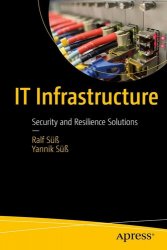IT Infrastructure: Security and Resilience Solutions
- Добавил: literator
- Дата: 8-05-2024, 14:49
- Комментариев: 0
 Название: IT Infrastructure: Security and Resilience Solutions
Название: IT Infrastructure: Security and Resilience SolutionsАвтор: Ralf Süß, Yannik Süß
Издательство: Apress
Год: 2024
Страниц: 352
Язык: английский
Формат: pdf, epub (true)
Размер: 31.3 MB
Embark on a comprehensive journey into the intricate world of IT infrastructure, with an in-depth look into the transformational role of secure, private data centers in today's digital era. This exploration uncovers the multi-faceted domains of IaaS, PaaS, and SaaS, examining the primary components of modern IT infrastructure—compute, storage, backup, and beyond. As technology continues to surge forward, cyber threats evolve in tandem, prompting a dire need for reinforced data center security and resilience.
This book provides readers with a holistic, layered understanding of IT operations in our interconnected age. You will dive deep into the heart of technological advancements, appreciating the symbiotic relationship between evolving hardware capabilities and the progressive nature of cloud services.
You will understand the intricacies of data center design, management, and the strategic role they play amid the growing reliance on both private and public clouds. Asindustries pivot towards a more digital-first approach, this book serves as a guiding star, illuminating the pathways, challenges, and opportunities of the vast IT infrastructure landscape.
“Computer software” is a collective term that encompasses the entirety of digital instructions that can be loaded and executed by a computer system. This includes everything from simple scripts to complex programs. At its core, software is what allows hardware to perform tasks and functions. One of the most fundamental pieces of software within any computer system is the operating system (OS). The OS acts as an intermediary between the computer hardware and the computer user. Its primary function is to control and coordinate the use of hardware resources, ensuring smooth operation. When a user interacts with a computer – whether it’s typing on a keyboard, clicking with a mouse, or running an application – it’s the operating system that interprets these actions and translates them into instructions that the hardware can understand. In essence, the OS serves as a bridge, allowing software applications to function on diverse hardware platforms without the need for developers to understand the intricacies of each specific hardware type.
Software applications, often simply referred to as “apps,” are designed to perform specific tasks or solve particular problems. The scope of these tasks varies widely, from basic functions like drafting a document in a word processor or calculating a spreadsheet to more advanced tasks such as simulating real-world environments for research, piloting drones, or even facilitating augmented reality experiences. Some applications, like those used for steering an autonomous car or predicting weekly weather patterns, employ advanced algorithms and require significant computational power.
The creation of these software applications hinges on the detailed description of tasks in the form of algorithms. An algorithm, in the realm of computer science, is a finite set of well-defined instructions for completing a task or solving a problem. Once an algorithm is conceptualized, it’s up to programmers to translate it into a computer-readable format. This translation is done using programming languages. There’s a multitude of languages available, each with its unique strengths, characteristics, and applications. Popular languages like C, Java, and Python offer a blend of flexibility, efficiency, and user-friendliness, making them favored choices among developers worldwide.
What You Will Learn:
Trace the rich history and evolution of data centers over the last 60 years
Get comprehensive insights into cloud services architecture, from IaaS to SaaS
Gain in-depth knowledge of data center facilities, infrastructure, and security
Know best practices in storage provisioning, administration, and cost management
Develop strategies and tools for ensuring data center security and resilience
Understand the multi-faceted world of IT support service in modern digital environments
Who This Book Is For:
IT professionals: from system administrators and network architects to IT managers and data center overseers, plus students and tech enthusiasts seeking deep insights into IT infrastructure.
Contents:
Скачать IT Infrastructure: Security and Resilience Solutions
Внимание
Уважаемый посетитель, Вы зашли на сайт как незарегистрированный пользователь.
Мы рекомендуем Вам зарегистрироваться либо войти на сайт под своим именем.
Уважаемый посетитель, Вы зашли на сайт как незарегистрированный пользователь.
Мы рекомендуем Вам зарегистрироваться либо войти на сайт под своим именем.
Информация
Посетители, находящиеся в группе Гости, не могут оставлять комментарии к данной публикации.
Посетители, находящиеся в группе Гости, не могут оставлять комментарии к данной публикации.

